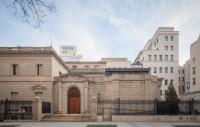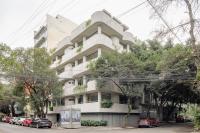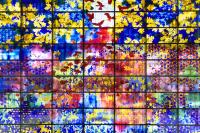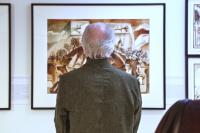Mountopia Tea Cofe
Yuyao City, China
Siming Mountain is located in Siming Mountain Town, Yuyao City, Ningbo, Zhejiang Province. It has the magnificent momentum of Longhu Mountain and the exquisite strange stones of Tuerling. It is known as a natural "oxygen bar". Sanyo Tea House is located on the top of the mountain and is a building renovation project based on the original tea mountain pavilion.
The first time I arrived at the scene was on a rainy day in April. As I walked up the road from the foot of the mountain, I thought of the scene described by Tao Yuanming in his work 'Peach Blossom Spring': 'At first, the path was narrow and only allowed one person to pass through. After walking a few dozen steps, it suddenly opened up'.
The existing building is a recreational supporting structure consisting of a wooden corridor and pavilion, and the two structures were not built at the same time. The site faces the Siming Lake and is backed by a bamboo forest on the surrounding mountains. The bamboo forests on the east and north sides give a strong sense of enclosure. In such a space with abundant natural resources, both we and the client believe that the project should establish a long-term connection with nature and reawaken users' perception of nature. Based on the spatial perception of the site, we propose two important design points as the starting point of the design: micro-intervention and landscape viewing.
The mountain is a kitchen, with ingredients and tools at the foot of the mountain, in the mountains, and among the trees. The firewood from the self-sustaining forest needs to be chopped down and ignited, instead of using coal gas and electricity. The firewood, combined with slow cooking, carries a message from the mountain: there is no need to be impatient, but to wait. Wait for breathing, wait for fruits and vegetables to ripen, wait for rainwater, wait for sunlight. When the time comes, the mountain will present its abundance to you.
The theme of mountain range is actually a proposition with very Chinese characteristics. Mountain range represents the concentrated embodiment of traditional Chinese humanistic emotions - the pursuit of a secluded environment. Although there is also a hermit culture in the West, the so-called Western retreat is a return to the original state, while the Chinese state of seclusion is physically far from the hustle and bustle, but internally pursuing higher-level cultural pursuits. This state is difficult to present in material form, just like Wang Yangming mentioned in 'Investigating Things and Extending Knowledge': human nature cannot be changed, and there is an inherent connection between 'intention' and 'action'. The core idea of traditional Chinese humanistic emotions may be to pursue such a realm. Therefore, our vision is to simplify and reduce people's dependence on physical space as much as possible on the basis of meeting the basic functional needs of the tea room, leaving more undefined space integrated with nature for users. This is crucial. Therefore, respect for and compliance with the environment become the main design orientation of our plan. The mountain range tea room has become a place for people to 'investigate things', which is also the original intention of building it.
One of the most striking features of the tea room is a long strip of folding windows facing Siming Lake, occupying an entire wall like a unique frame. In pleasant weather, these horizontally folding windows can be fully opened, allowing guests to enjoy the breathtaking scenery and the pleasant feeling of the breeze on their faces at any time.
The perception of architecture comes from various aspects, including space, light and shadow, materials, and experience, which together constitute the overall expression of the building. The interplay between materials not only involves the mutual influence of color and light and shadow, but also the tactile texture of materials. During the construction process, when the cement floor was first poured, I felt a sense of disharmony because the heaviness and roughness of this material seemed somewhat abrupt in the entire space. However, I decided to continue the construction and observe the development. When the walls were finished with micro-cement and stainless steel countertops, I looked back at that piece of antique-coated cement floor. At this point, its rough texture seemed to blend in naturally, and the layering of materials became apparent.
Based on the concept of ecological protection and restoration, furniture, doors, and shelves indoors and outdoors are all made on-site using local bamboo and wood materials. When sunlight shines on these weathered old woods, they exhibit a particularly natural texture and vivid colors. A balance needs to be struck between delicacy and roughness, as overly dense details may make people uncomfortable, while overly rough surfaces may appear crude. Therefore, it is crucial to accurately grasp this degree and relationship. At the same time, the architect's personal perception is also a key factor, as each of their decisions will affect the overall atmosphere of the building after completion.
We have designed seats of different heights, so that surprises will continuously occur as people's bodies and lines of sight change with the changing seating arrangements. The landscapes seen from the windows will also become rich and diverse. This playfulness arises when you inadvertently discover these viewing angles.
In accordance with the natural geographical features of the Yangmei Garden, several open-air business areas are created outdoors using an embedded approach. This is achieved by constructing retaining walls, paving with gray gravel, and using wooden furniture to weaken the sense of intrusion on nature in this area, blending it harmoniously with the surrounding environment.
The interaction with the surrounding environment is of utmost importance in any building. The environment itself has its unique atmosphere, and different surroundings give buildings different characteristics. Buildings that ignore the surrounding environment can only be considered as products that meet functional needs, without showcasing diversity and vitality. Engaging in architectural design in a rich and colorful environment is delightful. The surrounding streets, trees, villages, bamboo forests, mountains, etc. should all be taken into consideration in architectural design to create buildings that are vibrant and diverse. As the saying goes, 'People on the bridge are enjoying the scenery, while people in the building are being watched.' Things depend on and relate to each other, making life poetic. Standing at the foot of the mountain and looking at the tea house, the tea house itself becomes a scenery, and at the same time, people inside the tea house can fully appreciate the beautiful views of Siming Mountain and Siming Lake. There is a certain distance between people, but through observation and being observed, this subtle connection is integrated into the expression of space, adding interest and emotional depth.
- Architects
- Parallect Design
- Location
- 梁弄镇横路村, Yuyao City, China
- Year
- 2023
- Client
- Mountopia Project, Yuejie Brand Consulting
- Team
- Jiang Wu, Nan Yang, Xiangdong Xiao



































